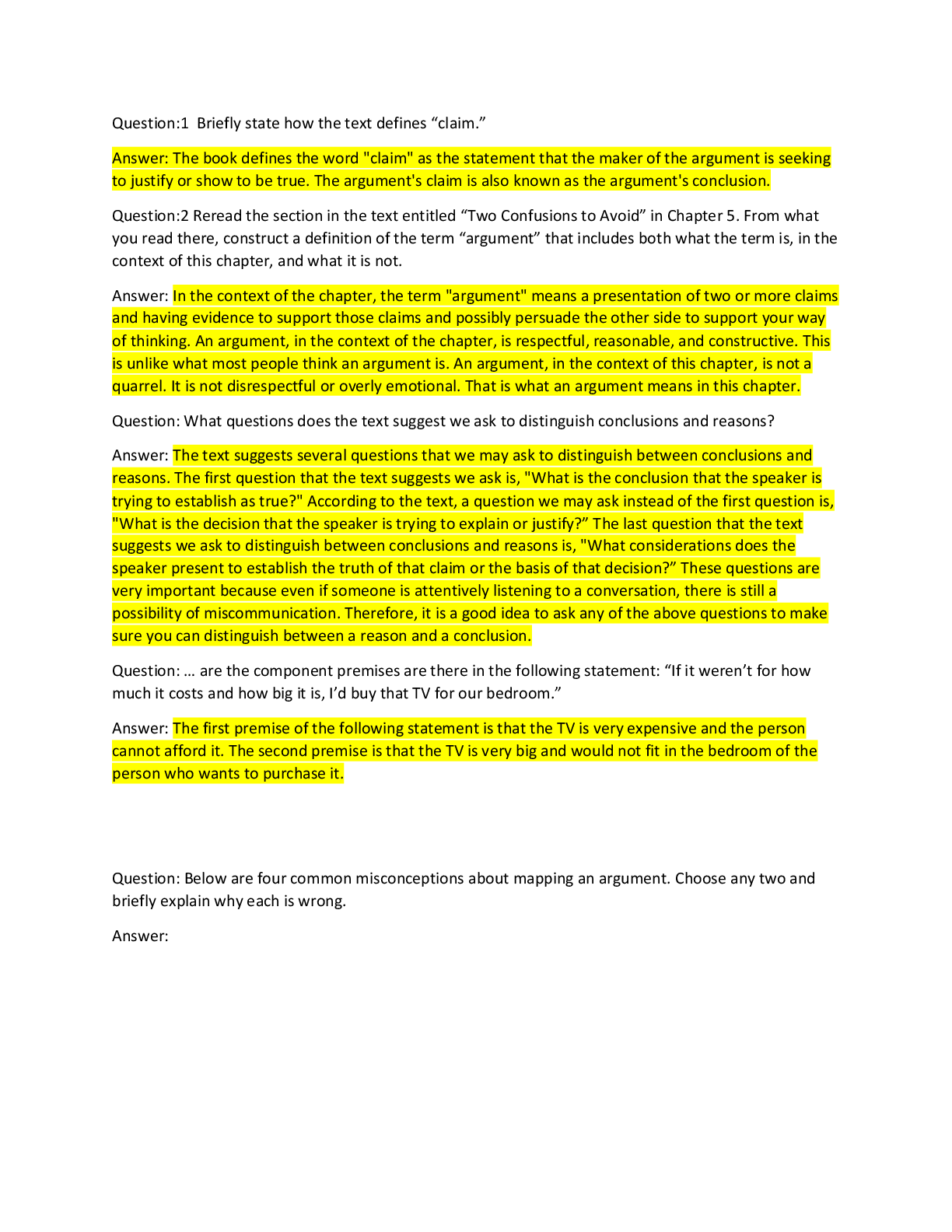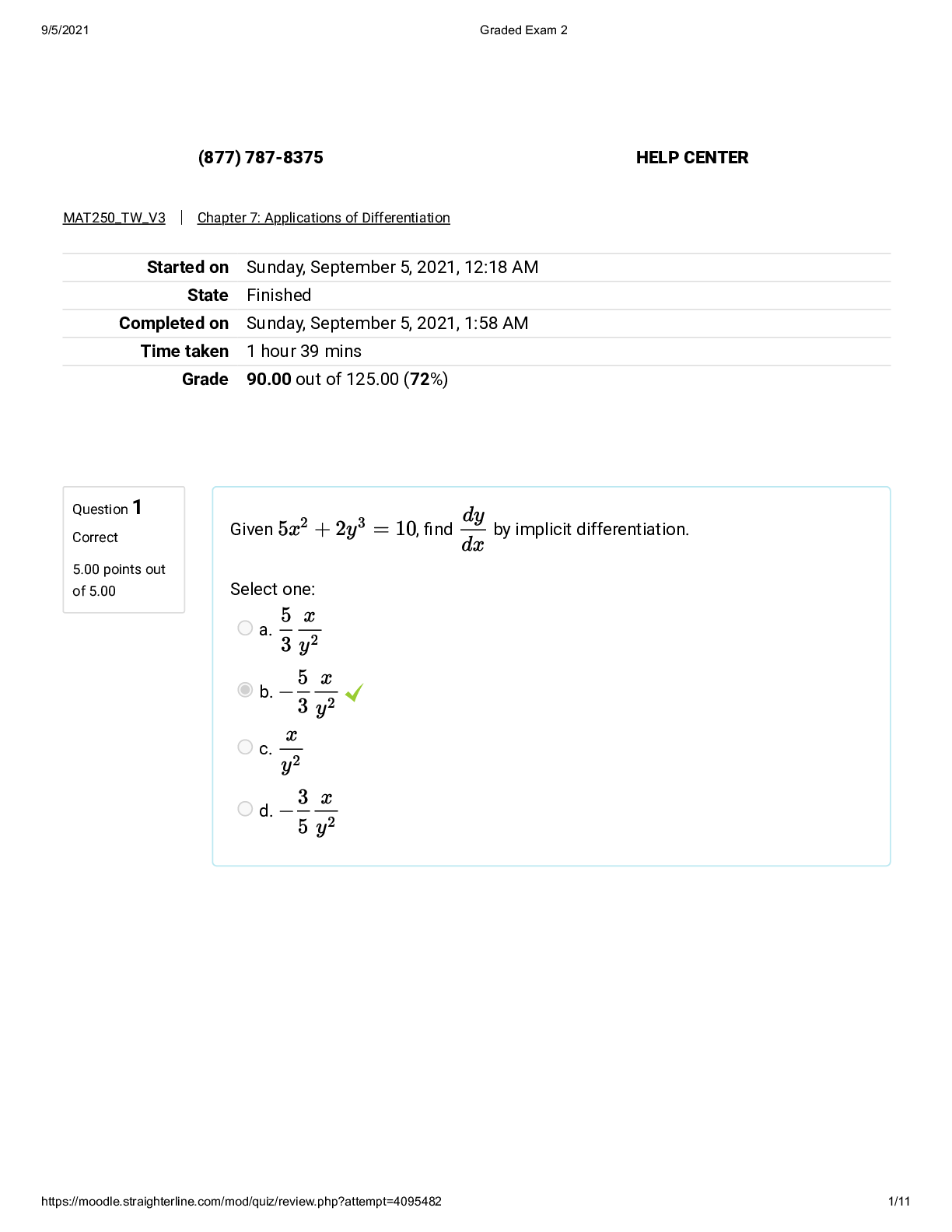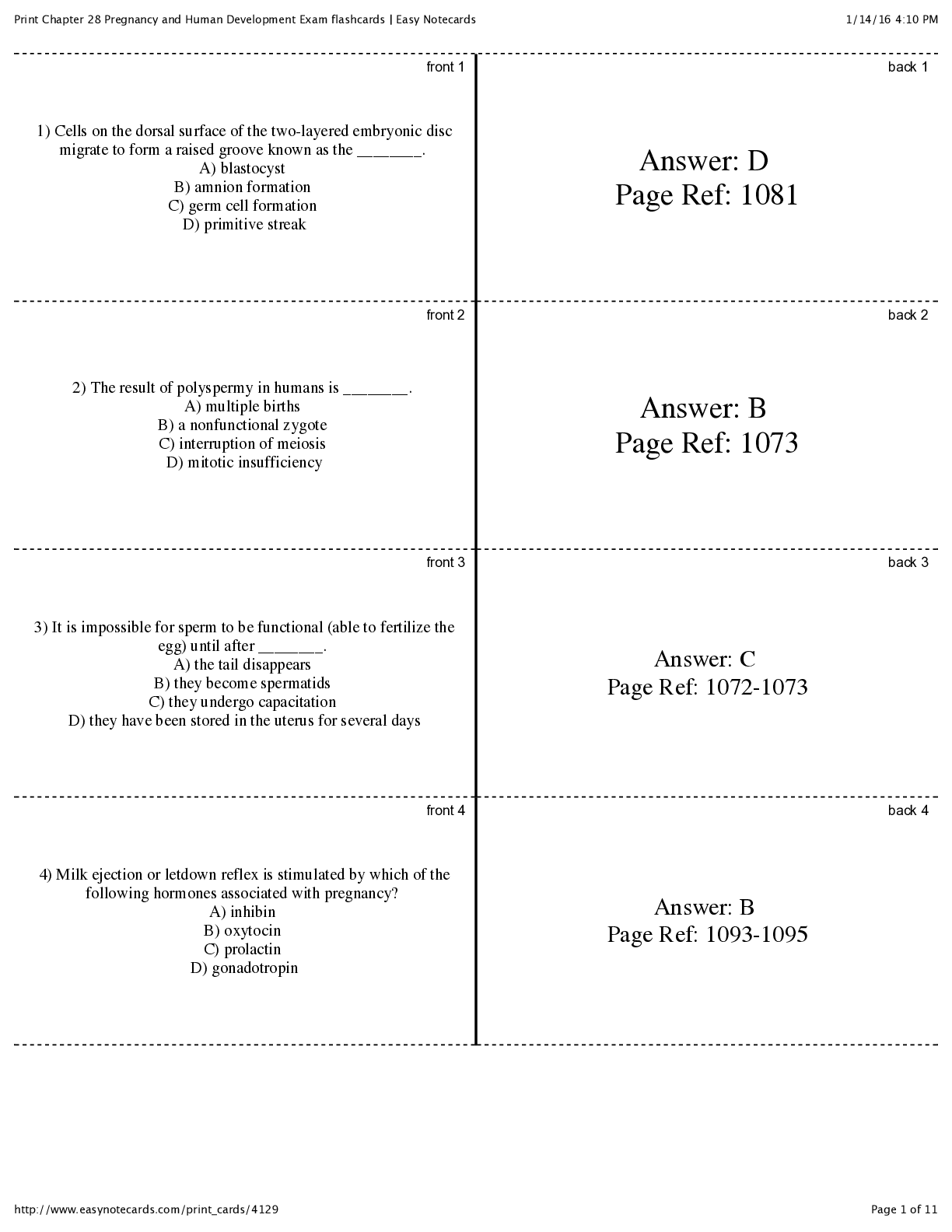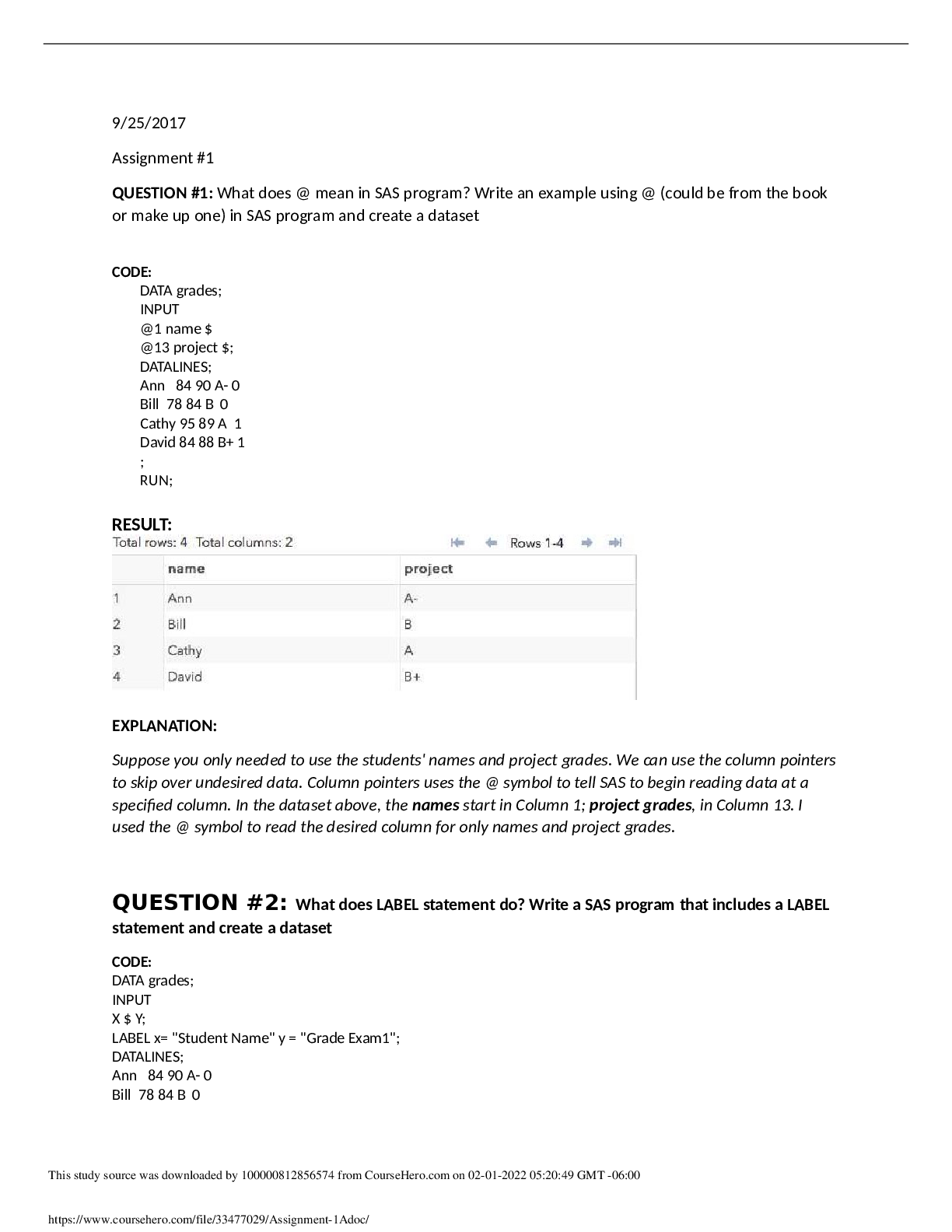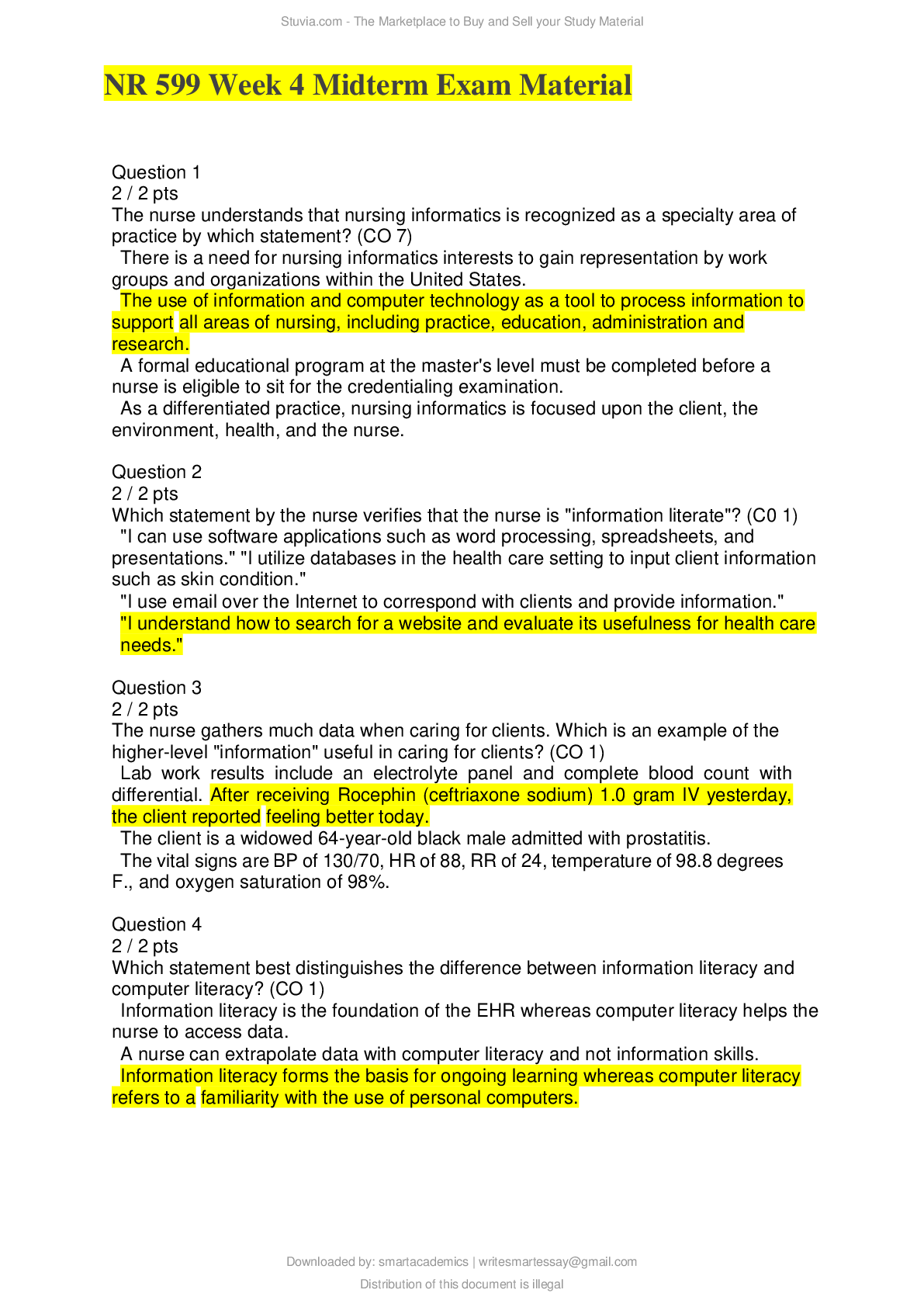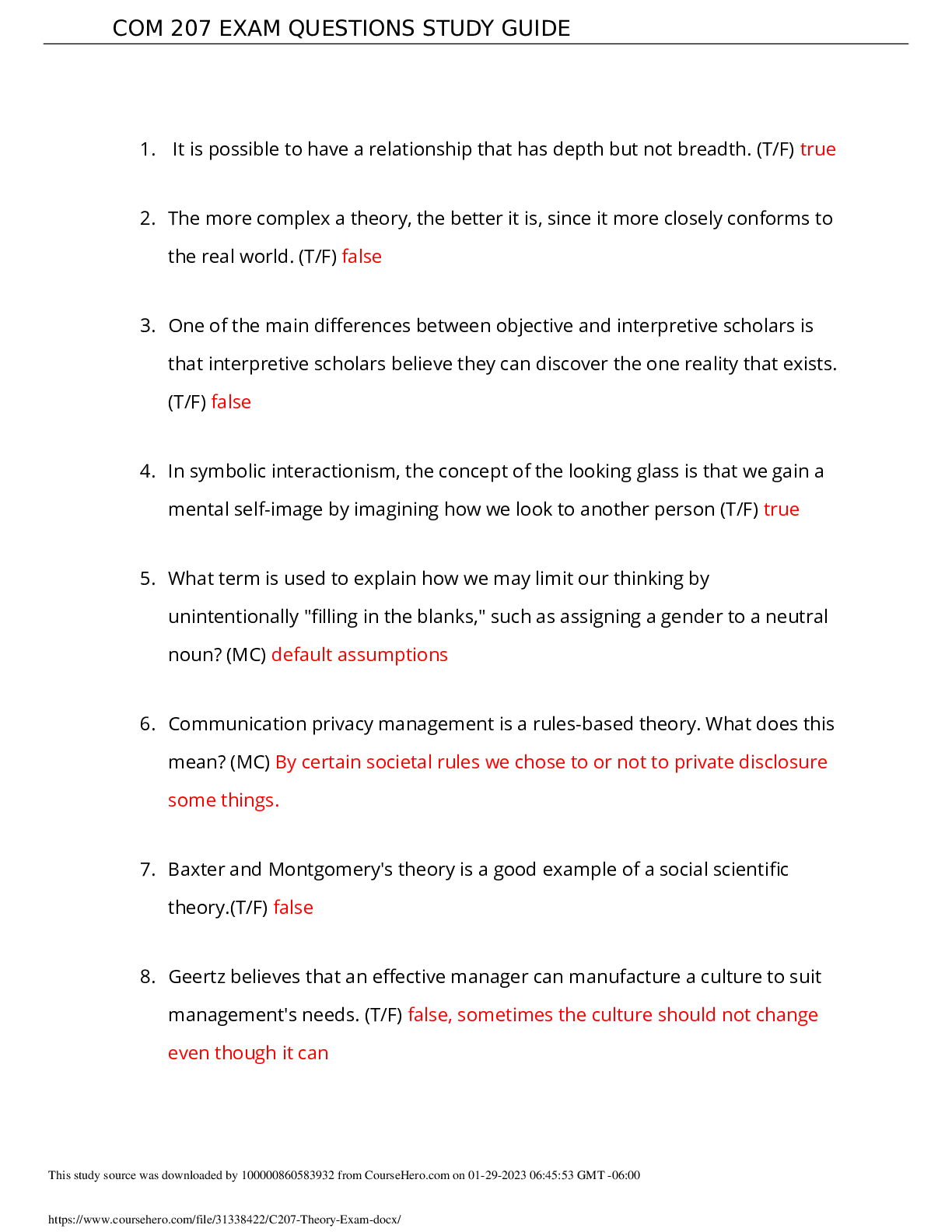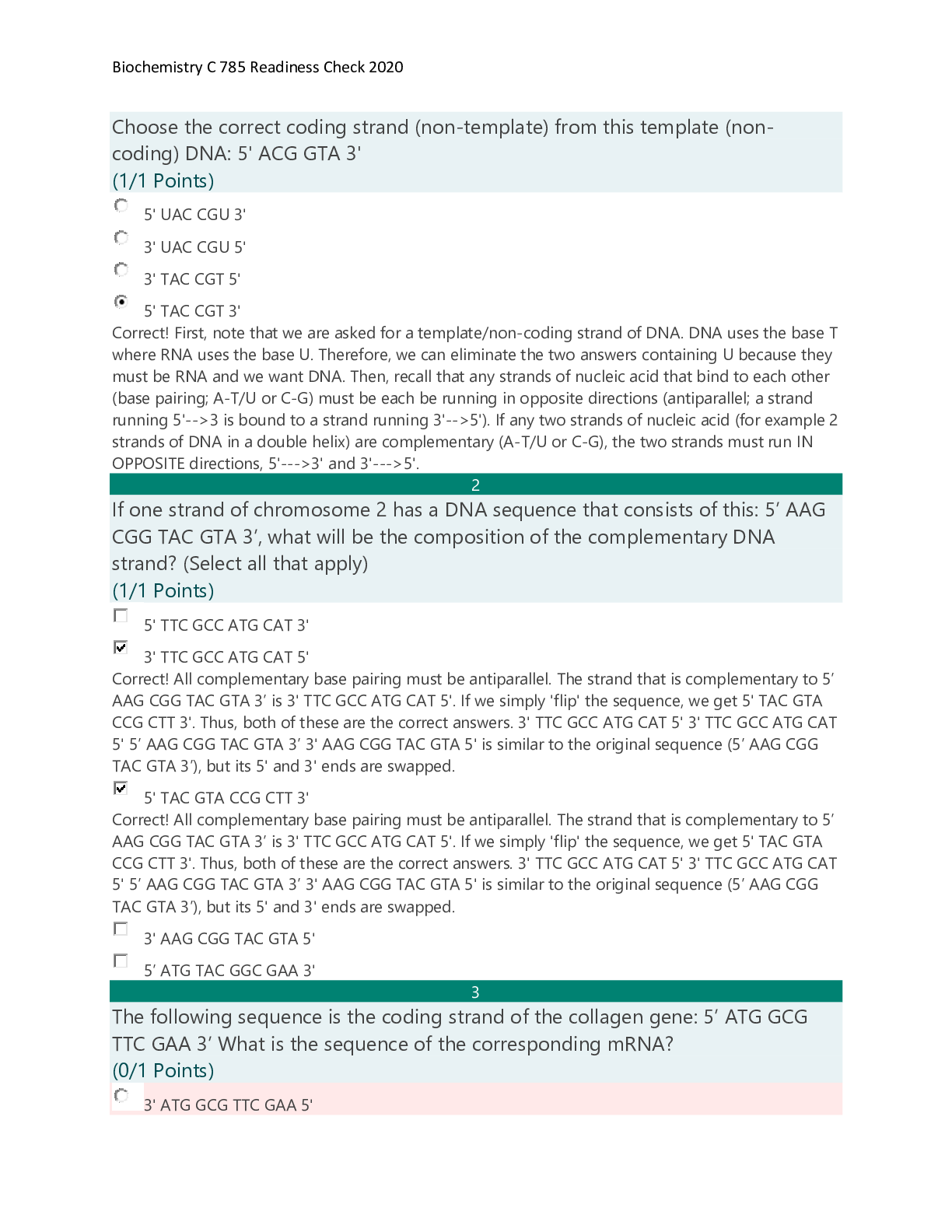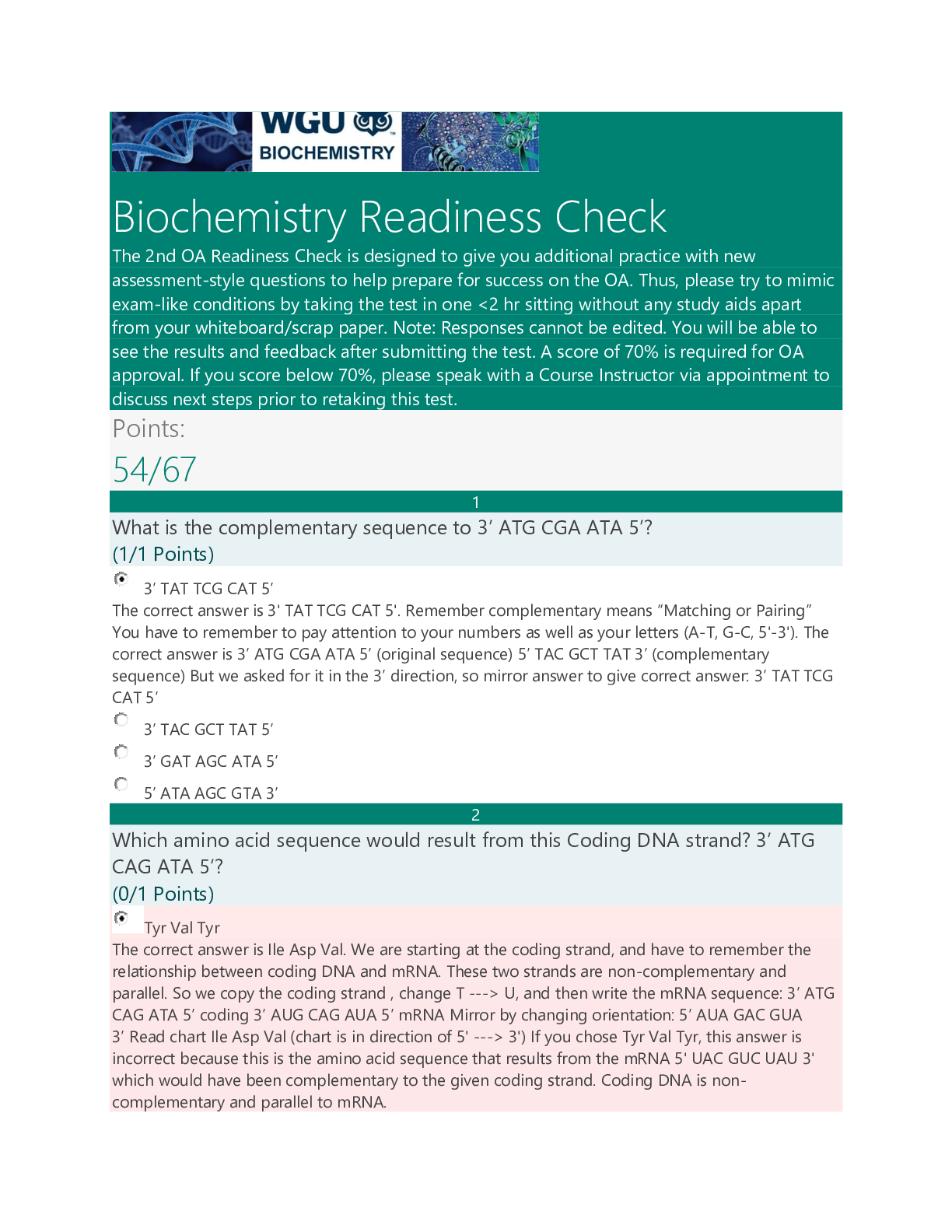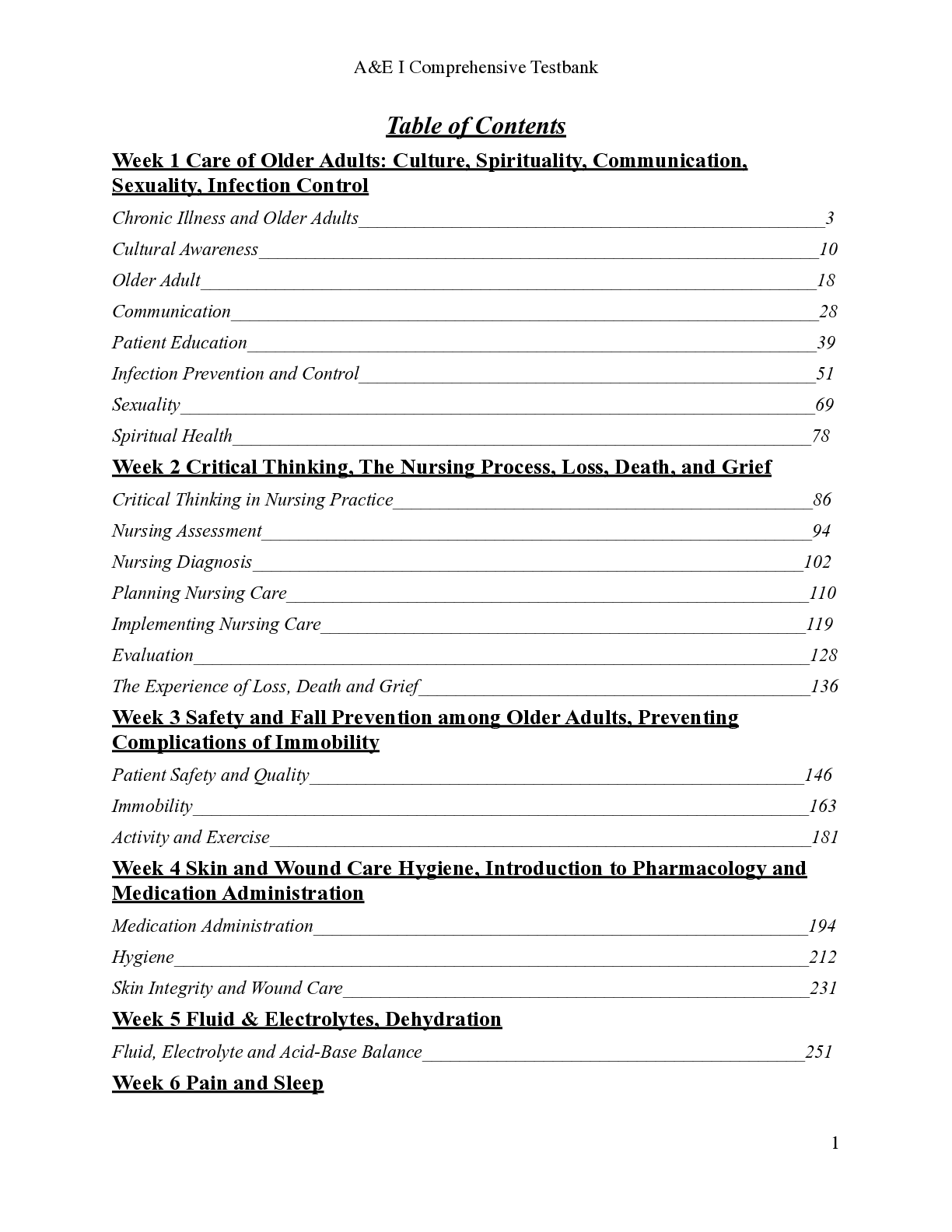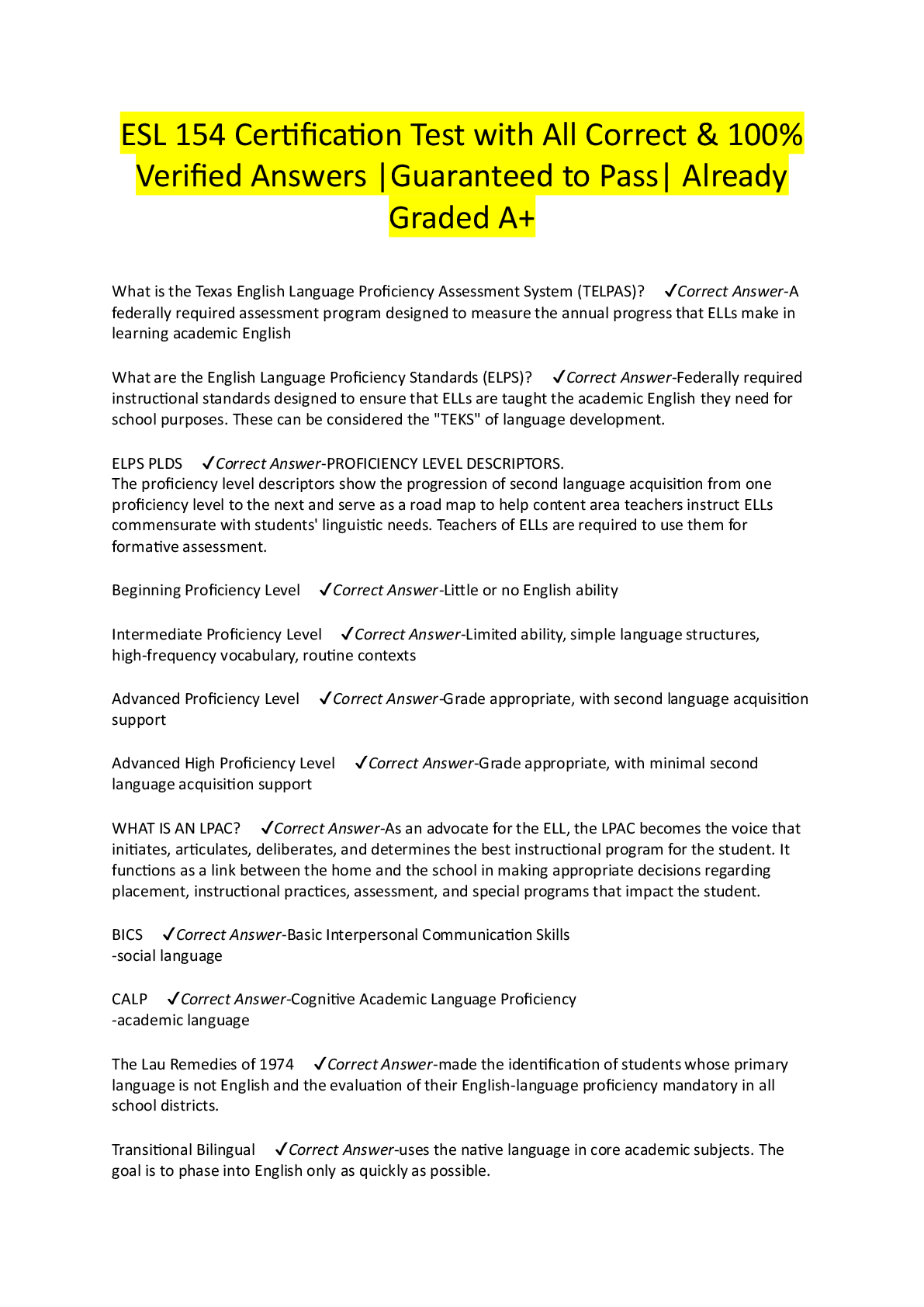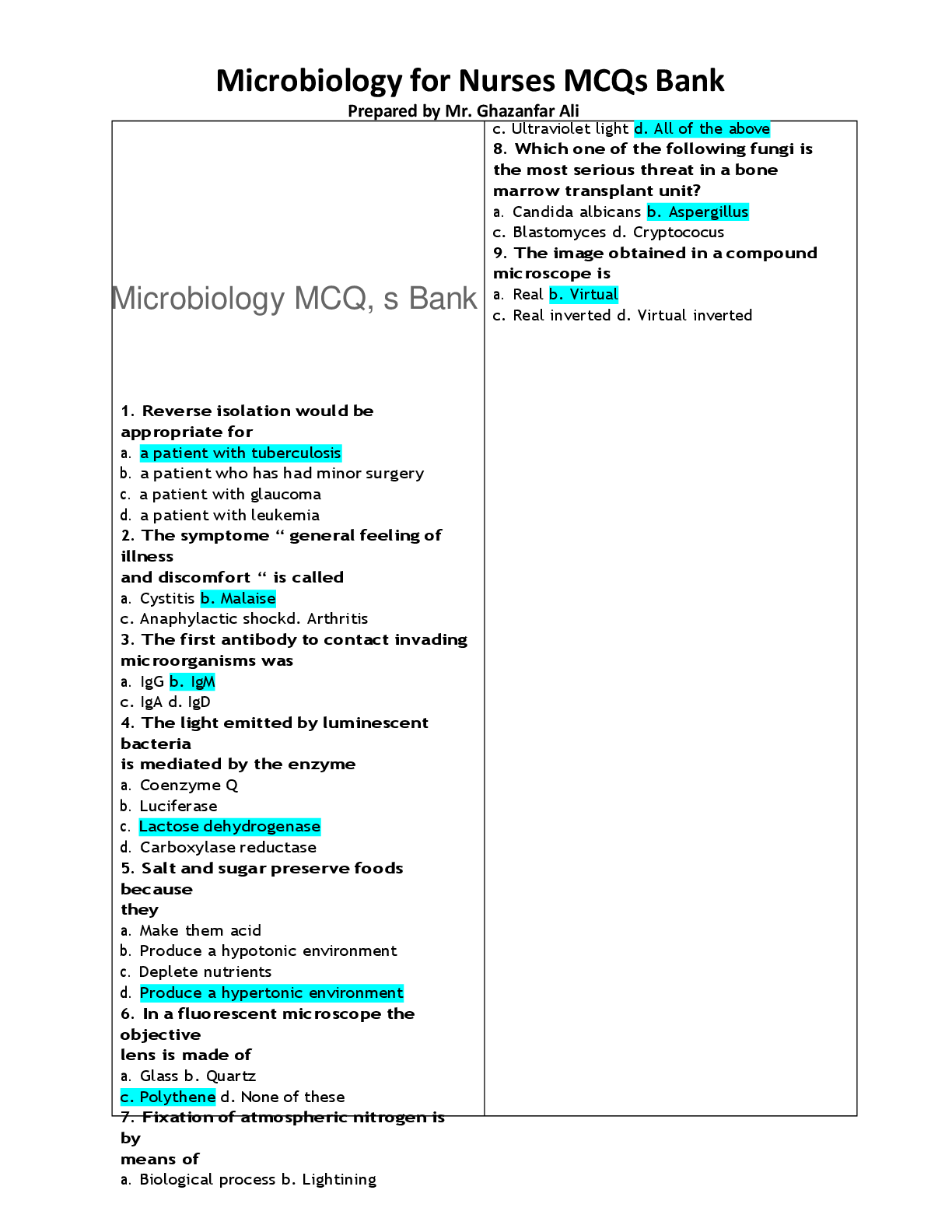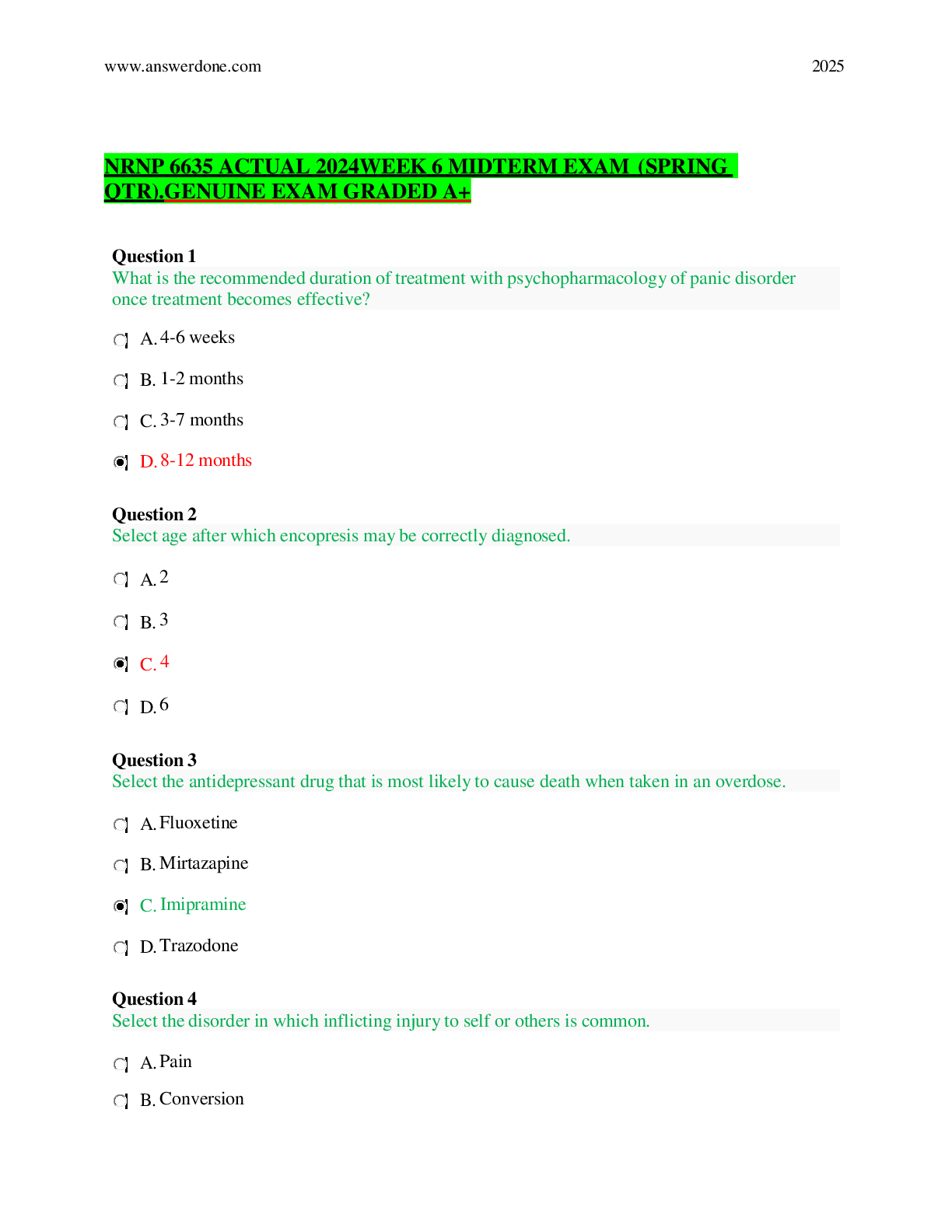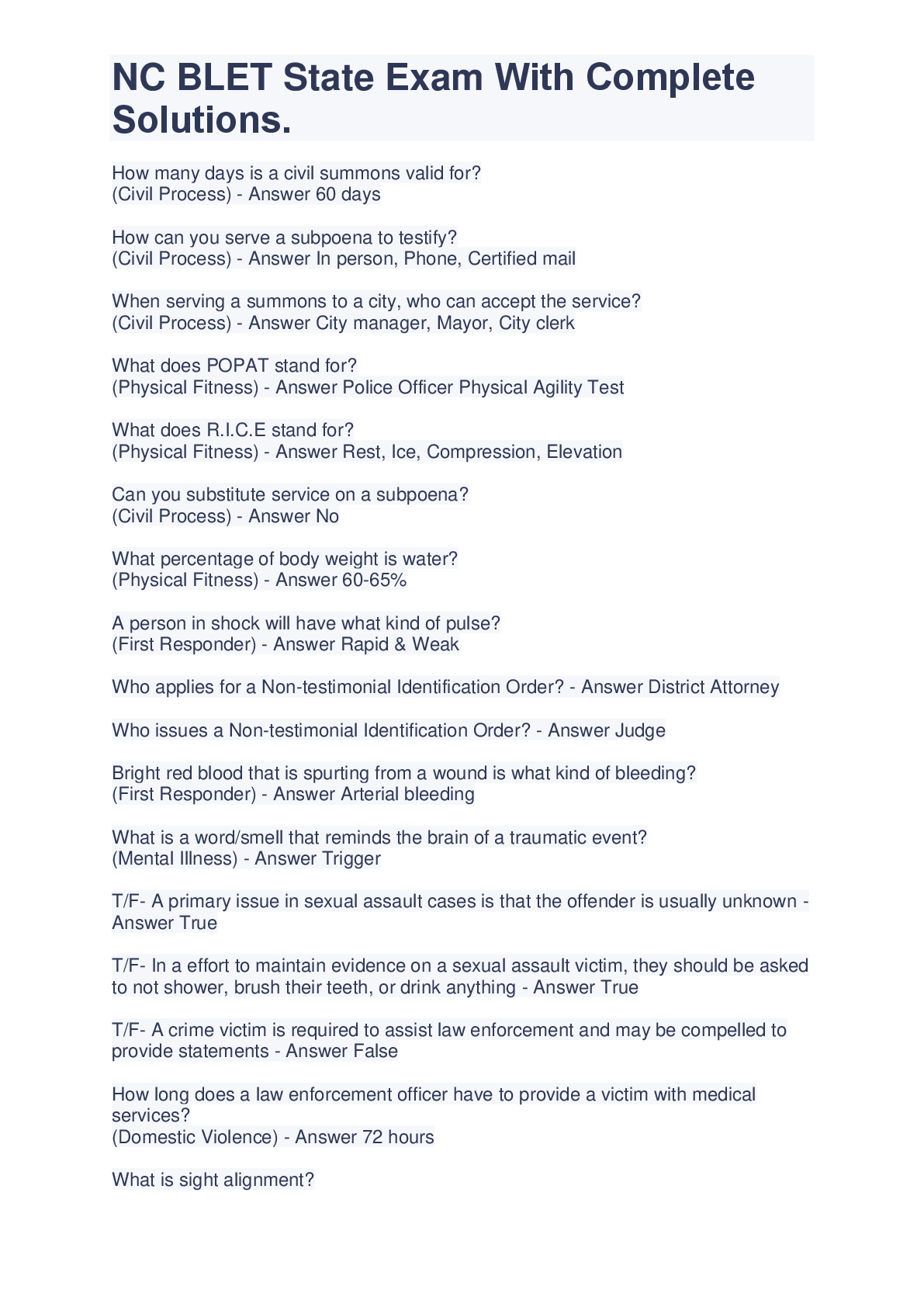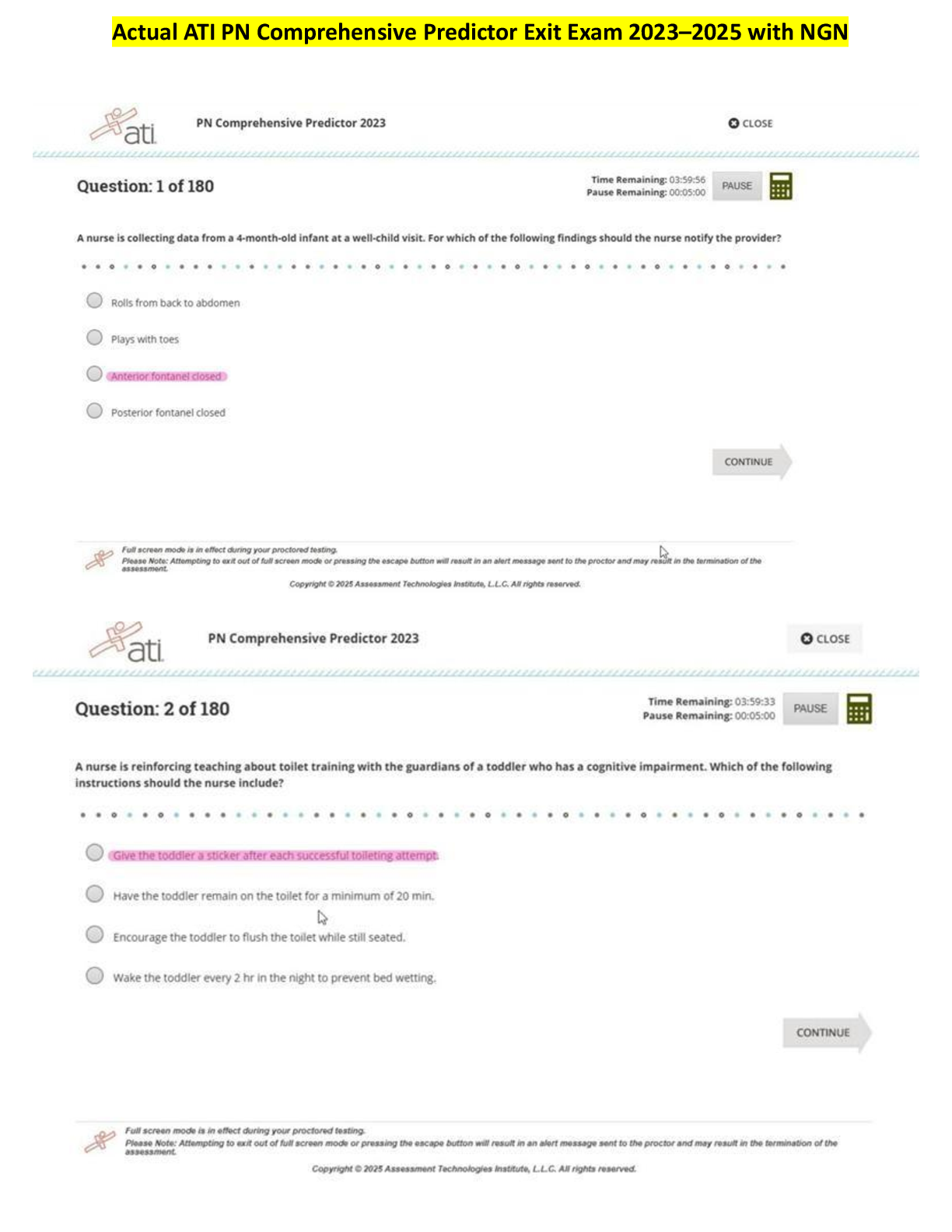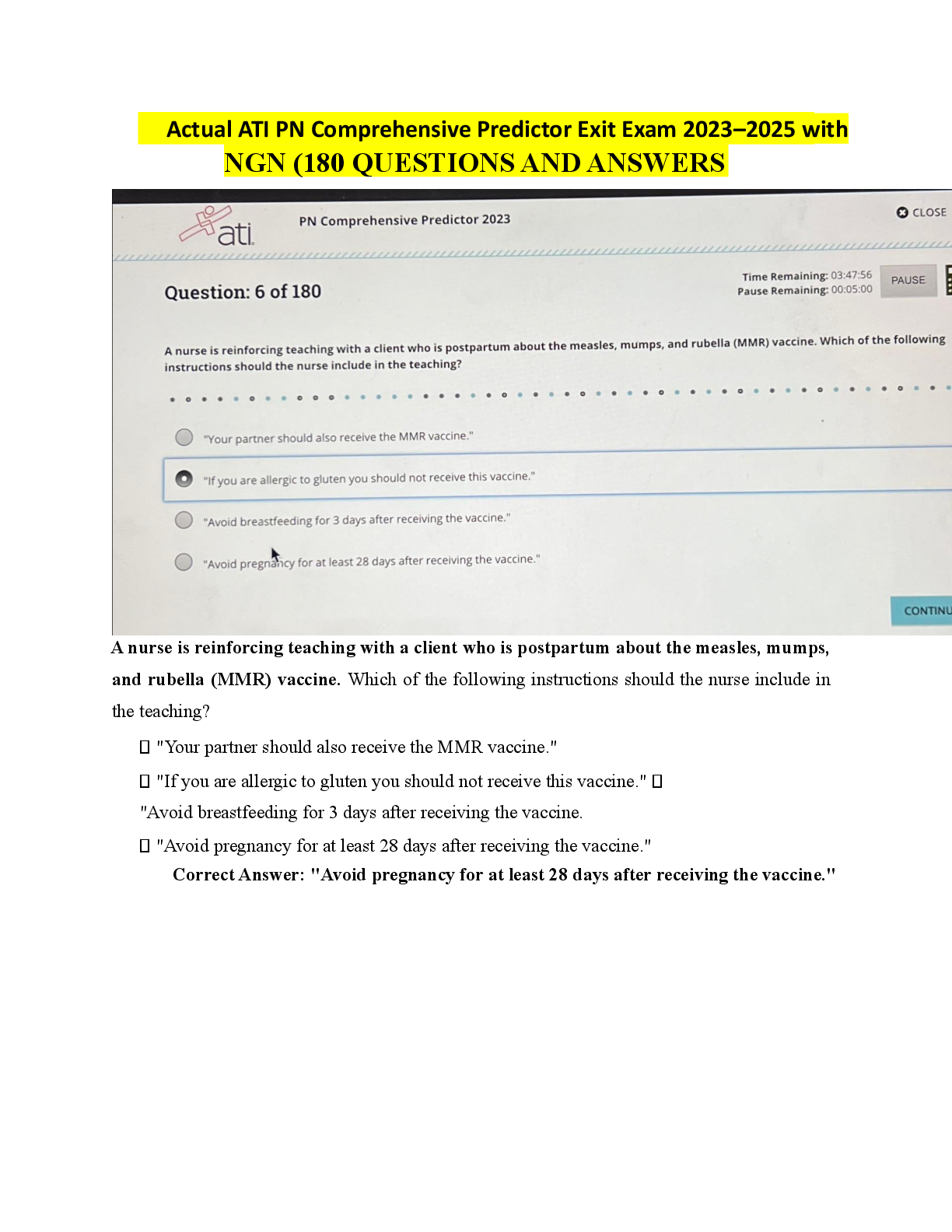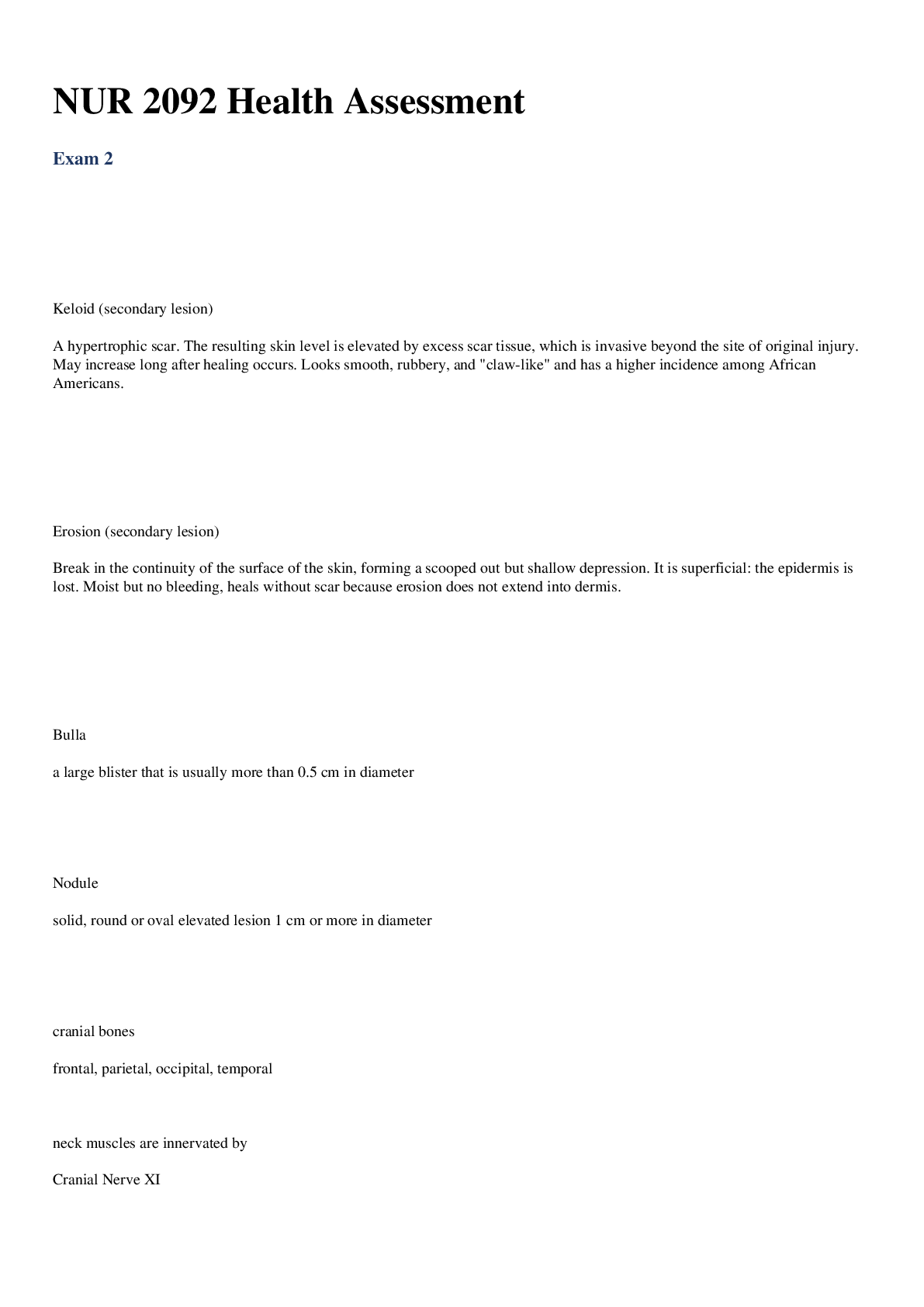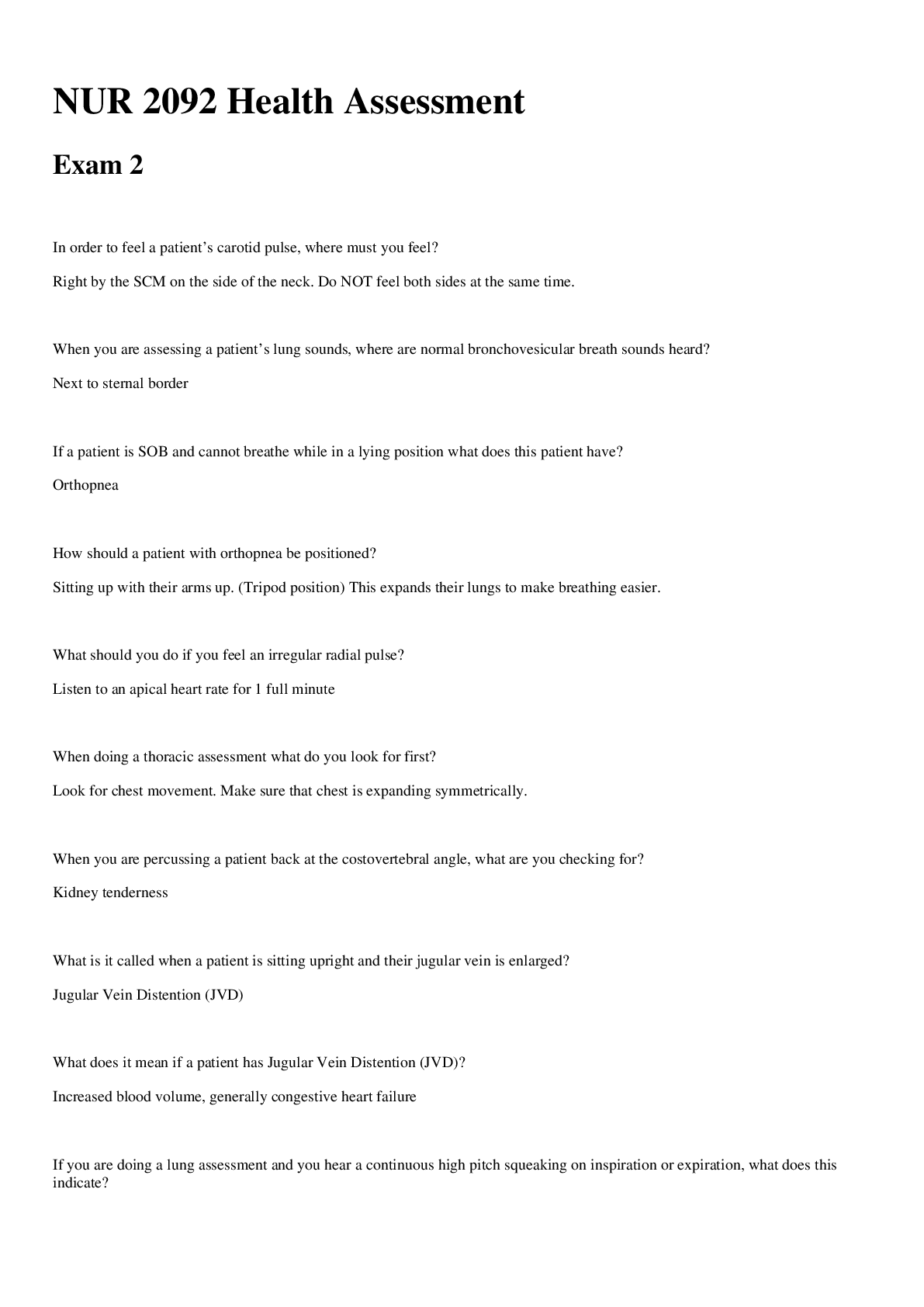Nursing Board Review: Psychiatric Nursing Practice Test Part 1 QUESTIONS AND ANSWERS 2020/2021
Document Content and Description Below
1. Before eating a meal, a female client with obsessive-compulsive disorder (OCD) must wash his hands for 18 minutes, comb his hair 444 strokes, and switch thebathroom lights 44 times. What is the mos
...
t appropriate goal of care for this client?
▪ a. Omit one unacceptable behavior each day
▪ b. Increase the client’s acceptance of therapeutic drug use
▪ c. Allow ample time for the client to complete all rituals before each meal
▪ d. Systematically decrease the number of repetitions of rituals and the amount of time spent performing them.
When caring for a client with OCD, the goal is to systematically decrease the undesirable behavior. (Therapy may not
completely extinguish certain behaviors.) Expecting to omit one behavior each day is unrealistic because the client may have used ritualistic behavior would perpetuate the undesirable behavior.
2. The nurse closely observes the client who has been displaying aggressive behavior. The nurse observes that the client’s anger is escalating. Which approach is least helpful for the client at this time?
▪ a. Acknowledge the client’s behavior
▪ b. Maintain a safe distance from the client
▪ c. Assist the client to an area that is quiet
▪ d. Initiate confinement measures
The proper procedure for dealing with harmful behavior is to first try to calm patient verbally. When verbal and psychopharmacologic interventions are not adequate to handle the aggressiveness, seclusion or restraints may be applicable. Options A, B and C are appropriate approaches during the escalation phase of aggression.
3. Clients who are suspicious primarily use projection for which purpose:
▪ a. deny reality
▪ b. to deal with feelings and thoughts that are not acceptable
▪ c. to show resentment towards others
▪ d. manipulate others
Projection is a defense mechanism where one attributes ones feelings and inadequacies to others to reduce anxiety. Option A, is not true in all instances of projection. Options C and D focuses on the self rather than others.
4. A 26 year old writer is admitted for the second time accompanied by his wife. He is demanding, arrogant talked fast and hyperactive. Initially the nurse should plan this for a manic client:
▪ a. set realistic limits to the client’s behavior
▪ b. repeat verbal instructions as often as needed
▪ c. allow the client to get out feelings to relieve tension
▪ d. assign a staff to be with the client at all times to help maintain control
The manic client is hyperactive and may engage in injurious activities. A quiet environment and consistent and firm limits should be set to ensure safety. Option B, clear, concise directions are given because of the distractibility of the client but this is not the priority. Option C, the manic client tend to externalize hostile feelings, however only non- destructive methods of expression should be allowed. Option D, nurses set limit as needed. Assigning a staff to be with the client at all times is not realistic.
5. A client with borderline personality disorder is admitted to the psychiatric unit. Initial nursing assessment reveals that the client's wrists are scratched from a recent suicide attempt. Based on this finding, the nurse should formulate a nursing diagnosis of:
▪ a. Ineffective individual coping related to feelings of guilt.
▪ b. Situational low self-esteem related to feelings of loss of control.
▪ c. Risk for violence: Self-directed related to impulsive mutilating acts.
▪ d. Risk for violence: Directed toward others related to verbal threats.
The predominant behavioral characteristic of the client with borderline personality disorder is impulsiveness, especially of a physically self-destructive sort. The observation that the client has scratched wrists doesn't substantiate the other options.
6. Which assessment finding is most consistent with early alcohol withdrawal?
▪ a. Heart rate of 120 to 140 beats/minute
▪ b. Heart rate of 50 to 60 beats/minute
▪ c. Blood pressure of 100/70 mm Hg
▪ d. Blood pressure of 140/80 mm Hg
Tachycardia, a heart rate of 120 to 140 beats/minute, is a common sign of alcohol withdrawal. Blood pressure may be labile throughout withdrawal, fluctuating at different stages. Hypertensiontypically occurs in early withdrawal.
Hypotension, although rare during the early withdrawal stages, may occur in later stages. Hypotension is associated with cardiovascular collapse and most commonly occurs in clients who don't receive treatment. The nurse
should monitor the client's vital signs carefully throughout the entire alcohol withdrawal process.
7. A client is admitted to the psychiatric clinic for treatment of anorexia nervosa. To promote the client's physical health, the nurse should plan to:
▪ a. severely restrict the client's physical activities.
▪ b. weigh the client daily, after the evening meal.
▪ c. monitor vital signs, serum electrolyte levels, and acid-base balance.
▪ d. instruct the client to keep an accurate record of food and fluid intake
An anorexic client who requires hospitalization is in poor physical condition from starvation and may die as a result of arrhythmias, hypothermia, malnutrition, infection, or cardiac abnormalities secondary to electrolyte imbalances. Therefore, monitoring the client's vital signs, serum electrolyte level, and acid base balance is crucial. Option A may worsen anxiety. Option B is incorrect because a weight obtained after breakfast is more accurate than one obtained after the evening meal. Option D would reward the client with attention for not eating and reinforce the control issues
that are central to the underlying psychological problem; also, the client may record food and fluid intake inaccurately.
8. Daisy Caparas is a 35 year old woman with two young children. She had been admitted withsevere depression. During the initial phase of the nurse-patient relationship, the most helpful nursing intervention for Mrs. Caparas is:
▪ a. alleviating symptoms
▪ b. assessing anxiety
▪ c. providing sympathy
▪ d. setting limits
During the initial phase of the nurse-patient relationship in this situation, tasks include establishing boundaries of the relationship, identifying problems, assessing anxiety levels, and identifying expectations. All other responses aren’t part of this phase of the relationship.
9. The best way to promote communication with Mrs. Caparas is to:
▪ a. allow her to remain isolated in her room
▪ b. ask for clarification and restate or paraphrase her statements
▪ c. place strict time limits on her efforts at communication
▪ d. tell her what you think is going on
Asking for clarification and restating or paraphrasing the patient’s statements are techniques used to further elicit and clarify the patient’s feelings. The other options aren’t recommended methods for promoting communication.
10. Techniques that may help Mrs. Caparas regain self-awareness include:
▪ a. discouraging comparison with other episodes in her life
▪ b. discouraging her assessment of emotions
▪ c. encouraging her to cry as frequently as needed
▪ d. encouraging reflection
Encouraging the patient to reflect enables her to think about the events and feelings and reach a conclusion. This may be help her gain confidence in making assessments and decisions, and it may encourage self-reliance.
11. The nurse is assessing a 16-year-old female who is being admitted for treatment of anorexia nervosa. Which clinical manifestation is the nurse most likely to find?
▪ a. Tachycardia
▪ b. Warm, flushed extremities
▪ c. Parotid gland tenderness
▪ d. Coarse hair growth
Frequent vomiting causes tenderness and swelling of the parotid glands. The reduced metabolism that occurs with severe weight loss produces bradycardia and cold extremities. Soft, downlike hair (called lanugo) may cover the extremities, shoulders, and face of an anorexic client.
12. The nurse formulates a nursing diagnosis of “impaired verbal communication” for a male patient with schizotypal personality disorder. Based on this nursing diagnosis, which nursing intervention is most appropriate?
▪ a. Helping the patient to participate in social interactions
▪ b. Establishing a one-on-one relationship with the patient
▪ c. Establishing alternative forms of communication
▪ d. Allowing the patient to decide when he wants to participate in verbal communication with you By establishing a one-to-one relationship, the nurse helps the patient learn how to interact with other people in new situations. The other options are appropriate but should take place only after the nurse-patient relationship is established.
13. A 27-year-old woman reports losing her sight in both eyes. She’s diagnosed as having conversion disorder and is admitted to the psychiatric unit. Which nursing intervention would be most appropriate for this client?
▪ a. Not focusing on his blindness
▪ b. Providing self-care for him
▪ c. Telling him that his blindness isn’t real
▪ d. Teaching eye exercises to strengthen his eyes
Focusing on the client’s blindness can positively reinforce the blindness and further promote the use of maladaptive behaviors to obtain secondary gains. The client should be encouraged to participate in his own care as much as possible to avoid fostering dependency. To promote self-esteem, give positive reinforcement for what the client can do. Blindness and other physical symptoms in a conversion disorder aren’t under the client’s control and are real to him. Eye exercises won’t resolve the client’s blindness because no organic pathology is causing the symptoms.
14. The client is arrogant and manipulative. In ensuring a therapeutic milieu, the nurse does one of the following:
▪ a. Agree on a consistent approach among the staff assigned to the client.
▪ b. Suggest that the client take a leading role in the social activities
▪ c. Provide the client with extra time for one on one sessions
▪ d. Allow the client to negotiate the plan of care
Agree on a consistent approach among the staff assigned to the client. A consistent firm approach is appropriate. This is a therapeutic way of to handle attempts of exploiting the weakness in others or create conflicts among the staff. Bargaining should not be allowed. Option B, this is not therapeutic because the client tends to control and dominate others. Option C, limits are set for interaction time. Option D, allowing the client to negotiate may reinforce manipulative behavior.
15. Jade Gomez is a 33 year old housewife. She has been diagnosed with clinical depression. In a therapeutic relationship, the nurse assumes which role with Mrs. Gomez?
▪ a. Doer
▪ b. Friend
▪ c. Helper
▪ d. Listener
A therapeutic relationship is a helping relationship.
16. when beginning a therapeutic relationship with Mrs. Gomez, the first phase of nurse-patient interactions is known as the:
▪ a. helping phase
▪ b. orientation phase
▪ c. talking phase
▪ d. working phase
During the orientation phase of the therapeutic relationship, the nurse and patient make an agreement that they will be working together to solve one or more of the patient’s problems.
17. Which statement about patient touch is true?
▪ a. Most patients prefer not to be touched.
▪ b. Most patients prefer to be touched.
▪ c. Nurse-patient touching is an issue that requires sensitivity on the part of the nurse.
▪ d. Patients should never be touched.
Touch has many meanings to patients. Although many patients are eager for human touch, others may perceive touch as human-boundary violation. Therefore, touching requires sensitivity on the part of the nurse.
18. Tourette syndrome is characterized by the presence of multiple motor and vocal tics. A vocal tic that involves repeating one's own sounds or words is known as:
▪ a. echolalia.
▪ b. palilalia.
▪ c. apraxia.
▪ d. aphonia.
Palilalia is defined as the repetition of sounds and words. Echolalia is the act of repeating the words of others. Apraxia is the inability to carry out motor activities, and aphonia is the inability to speak.
19. Anxiety is caused by:
▪ a. an objective threat
▪ b. a subjectively perceived threat
▪ c. hostility turned to the self
▪ d. masked depression
Anxiety is caused by a subjectively perceived threat. Option A, Fear is caused by an objective threat. Option C, a depressed client internalizes hostility. Option D, mania is due to masked depression.
20. A 29 year old client newly diagnosed with breast cancer is pacing, with rapid speech headache and inability to focus with what the doctor was saying. The nurse assesses the level of anxiety as:
▪ a. Mild
▪ b. Moderate
▪ c. Severe
▪ d. Panic
The client’s manifestations indicate severe anxiety. Option A, mild anxiety is manifested by slight muscle tension, slight fidgeting, alertness, ability to concentrate and capable of problem solving. Option B, moderate muscle tension, increased vital signs, periodic slow pacing, increased rate of speech and difficulty in concentrating are noted in moderate anxiety. Option D, panic level of anxiety is characterized immobilization, incoherence, feeling of being overwhelmed and disorganization
21. Winnie Cruz is a 33 year old woman who is admitted to the hospital for observation after she attempted suicide. The nurse includes a psychosocial assessment that includes Mrs. Cruz’s marital relationship, based on the nurse’s knowledge that:
▪ a. spouses are often the first to be aware of a potential suicide
▪ b. spouses may be able to intervene in future suicide attempts
▪ c. suicide attempts may adversely affect the marital relationship
▪ d. the number one risk factor for suicide in adult woman is spousal abuse
Information regarding the patient’s relationship with her spouse is important because spousal abuse is the leading cause of attempted and actual suicides in adult women.
22. Psychiatric follow-up for Mrs. Cruz is essential because she:
▪ a. is definitely depressed
▪ b. is probably angry that she’ll still alive
▪ c. may try to commit suicide again
▪ d. obviously hates her life
Patients who have attempted suicide are at much higher risk for repeat attempts in the future.
23. Kevin, a 21 year old college student fell from a train and sustained a spinal cord injury, leaving him paralyzed below the waist. He’s in a spinal cord rehabilitation program and is refusing to do things for himself or practices in his prescribed program. One of Kevin’s nursing diagnosis is self-esteem disturbance. Which of the following is the most therapeutic nursing intervention?
▪ a. asking his friends to encourage self-care
▪ b. enlisting him in the planning of his own care
▪ c. moving him to a different hospital environment
▪ d. teaching him to perform self-care measures
Encouraging a patient to be as independent as possible will promote self-reliance and self-confidence, both of which are components of a healthy self-esteem. An effective means of encouraging this independence is enlisting the patient in the planning of his won care. Teaching self-care measures and eliciting his peers to encourage him will be beneficial, but they are not as focused on fostering a healthy self-esteem. Moving Mr. Kevin to a different hospital environment isn’t indicated based on the data given.
24. The nurse says to Kevin, “Tell me about your plans after hospitalization.” Mr. Kevin replies, “I think in a few months I’ll pick up where I left off- back in college doing what I was doing before.” Which stage of the grief process is Mr. Kevin demonstrating?
▪ a. Acceptance
▪ b. Anger
▪ c. Bargaining
▪ d. Denial
Mr. Kevin is going through the grief-loss process because he has permanently lost the use of his legs due to paralysis. His comment suggests that he’s in denial, the first stage of the process. Denial is a coping mechanism that allows the individual time to assimilate the major changes associated with body function loss.
25. Which is the drug of choice for treating Tourette syndrome?
▪ a. fluoxetine (Prozac)
▪ b. fluvoxamine (Luvox)
▪ c. haloperidol (Haldol)
▪ d. paroxetine (Paxil)
Haloperidol is the drug of choice for treating Tourette syndrome. Prozac, Luvox, and Paxil are antidepressants and aren't used to treat Tourette syndrome.
[Show More]
Last updated: 3 years ago
Preview 1 out of 7 pages






.png)
